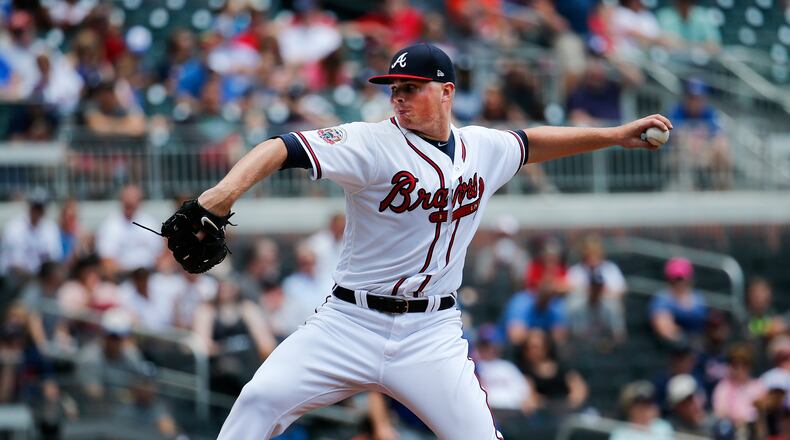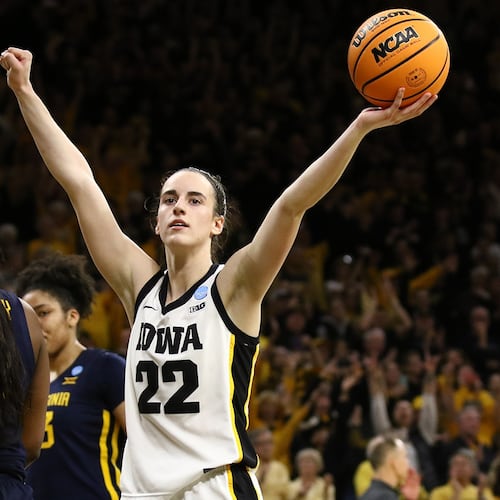The minor-leaguer who had issues throwing strikes hit the majors and made like Greg Maddux. Sean Newcomb’s first 10 pitches as an Atlanta Brave were strikes. Twenty of his first 22 were strikes. The first two batters he faced struck out.
After one big-league start, Newcomb’s ERA is 0.00. He threw 96 pitches Saturday, 70 of them strikes. He walked two, one on purpose. He struck out seven. He yielded four hits, all singles, none in the same inning. He threw only one bad ball, and that wasn’t to home plate. It was to second base after fielding a grounder, an error that begat the run that kept the debutante from exiting with a no-decision, as opposed to an official loss.
Newcomb left with the Braves trailing 1-0. They would lose 6-1, and enough about that. For a team that hasn’t cared much about W’s and L’s lately, this was a loss to wear with pride. Newcomb replaced Bartolo Colon – on the disabled list with a 7.78 ERA and an obliquely “strained oblique” – and left us to us wonder where these Braves might be if they’d trusted the young left-hander a couple of months earlier. But forget that, too. What’s done is done.
What matters is that another high-profile young arm is in the majors, and if you see much resemblance between Newcomb and Aaron Blair … well, you’ve spotted something I haven’t. Newcomb was unawed by the occasion – he admitted afterward he “expected more” jitters – and once umpire Tom Hallion rang up Juan Lagares and then Michael Conforto on called third strikes, both times on curveballs after three four-seamers ranging from 92 mph to 95, he acted as if he owned the place. Which he pretty much did.
“Satisfying to watch,” was Braves manager Brian Snitker's assessment of Newcomb’s 6 1/3 innings, and that description hasn't applied to many starts made by these pitchers. “He was outstanding. That might have been his best outing as pro.”
Snitker declined to say when Newcomb’s next big-league start will come, but this was exactly what the team that has torn down everything to rebuild around pitching has awaited – a bravura showing by a young pitcher. Yes, rebuilding is a process, and yes, appearances can deceive. But the Braves really need Newcomb to be good. He just showed that he can be. They have to stick him in this rotation and see what happens. Can’t do any worse than Colon, can he?
The Braves acquired Newcomb from the Angels in the Andrelton Simmons trade of November 2015. At the time, he was considered almost-big-league-ready, but his promotion was delayed by an inability to command his considerable array of pitches. The thought of a ballyhooed arm coming up and walking the ballpark scares every organization; the Braves took pains not to let that happen. But the guy threw so many strikes Saturday that it would be a shock if this was a one-off.
The 2017 Mets, unlike Mets of recent vintage, can actually hit. For this game they welcomed back Yoenis Cespedes, just off the disabled list. (He would hoist the clinching grand slam off Luke Jackson after Snitker chose to walk Michael Conforto with first base open.) Apart from the inning where the Mets scored their unearned run, they put only one man in scoring position against Newcomb. He was never fazed.
Of his seven strikeouts, five came on breaking pitches. (“The curveball has always been there,” Newcomb said. “The slider is something I’m working on.”) He hit 96 mph once – against Cespedes in the first inning – and sat at 93 and 94 consistently. And yet: He didn’t try to short out the radar gun. He stayed, as the baseball argot has it, within himself.
The longest at-bat of his day came against Wilmer Flores, who managed the Mets’ first two hits, in the sixth. Flores fouled off two two-strike fastballs, then a 79-mph curve. About here, a young pitcher – Newcomb turns 24 on Monday – might be thinking, “What do I do?” This young pitcher followed the curveball with another four-seamer. Flores waved at it.
Two innings earlier, Newcomb started Rene Rivera with four consecutive breaking pitches -- curve, slider, curve, curve – all in the 78/79-mph range. With the count 1-2, Newcomb finally threw his fastball. Rivera missed it badly. The point being: This wasn’t just throwing; this was actual pitching – by a 23-year-old working Game 1 in the bigs.
In the clubhouse afterward, another Braves left-hander recalled his debut. “It was Aug. 17,” Tom Glavine said. “In the Astrodome. We lost.”
Who got hits off him? “It would be easier to name the ones who didn’t.” Then, brightening: “(Ken) Caminiti was my first strikeout.” (It was Glavine's one and only that short night. It came in the third inning, by which time the Braves trailed 4-0. Glavine would leave with two out in the fourth and his team down 6-nil.) “But I won my next one,” he said.
Nobody watching that game on TBS in 1987 would have said, “That young fellow’s bound for Cooperstown.” With pitchers, nobody knows anything. Newcomb’s first big-league start might prove to be his best. But a Hall of Famer who watched was duly impressed. “If this is what he’s like,” Glavine said, “he just needs to keep doing what he’s doing.”
If this is what Sean Newcomb is really like, the team that has banked everything on young pitching will have banked a big lefty. And that Andrelton Simmons trade won’t seem nearly so bad.
About the Author
The Latest
Featured



